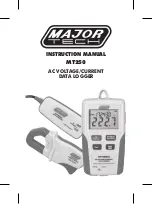
USB DrDAQ User's Guide
21
Copyright © 2013 Pico Technology Ltd. All rights reserved.
usbdrdaq.en r4
You should end up with a table something like this:
Chemical
Measured humidity
Standard humidity
Temperature
Potassium chloride
81%
85%
20°C
Magnesium nitrate
50%
54%
21°C
Magnesium chloride
30%
33%
20°C
Keep this table for further reference. It will be useful if you have to reset the software
with the PicoLog Recorder
New Settings
command.
At this stage compare the measured and standard values. If you find that the
measured values differ from the standard values by more than 10%, then there is
something wrong. You may have had an unsaturated solution, some contamination in
the solution, inadequate sealing of your test container, or possibly a damaged sensor.
Check your calibration routine. If you still get large errors contact Pico for assistance.
If you are using a calibrated reference this should give values very close to those
quoted for your standard solutions. If these values disagree by more than a few
percent there may be an error in your calibration procedure. When the two are in
agreement use the values given by the calibrated reference as the correct figures for
your data table.
Once you have your calibration data you must enter it into the Pico software to
calibrate the sensor:
1.
Open the PicoLog
Parameter Scaling
Dialog.
2.
Start PicoLog Recorder.
3.
Click on
Settings
.
4.
Click on
Input Channels
. The
DrDAQ Measurements
dialog appears.
5.
Select the input channel for the humidity sensor, for example 'External 1
Humidity'.
6.
Click on the
Edit
button. The
Edit DrDAQ Measurements
dialog appears.
7.
Click on the
Options
button. The
Parameter Options
dialog appears.
8.
Click on the
Scaling
button. The
Parameter Scaling
dialog appears.
9.
Enter your calibration data.
10.
Pull down the
Scaling Method
list and select
Table lookup
.
11.
To start your calibration table, click in the white rectangle. The text cursor
appears.
12.
Type in the value that you measured with the DD101 under
Raw
. Type a space
then enter the standard value under
scaled
. Press
Enter
.
13.
Enter all the pairs of measured and standard values that you have to build your
table. You should end up with two columns of values. Note - your table must
have at least two pairs of values.
14.
Click
OK
to close the dialogs.
15.
Click
OK
to close the
Parameter Scaling
dialog. The
Parameter Scaling
dialog
closes.
16.
Click
OK
to close the
Parameter Options
dialog. The
Parameter Options
dialog closes.
17.
Click
OK
to close the
Edit DrDAQ Measurements
dialog. The
Edit DrDAQ
Measurements
dialog closes.
18.
Click
OK
to close the
DrDAQ Measurements
dialog. The
DrDAQ
Measurements
dialog closes.
This completes the entry of the calibration data.
















































